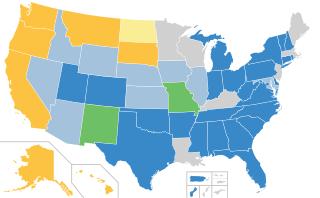Related Research Articles
ICC may refer to:
The National Institute of Standards and Technology (NIST) is a physical sciences laboratory and non-regulatory agency of the United States Department of Commerce. Its mission is to promote American innovation and industrial competitiveness. NIST's activities are organized into laboratory programs that include nanoscale science and technology, engineering, information technology, neutron research, material measurement, and physical measurement. From 1901 to 1988, the agency was named the National Bureau of Standards.

The International Chamber of Commerce is the largest, most representative business organization in the world. Its over 45 million members in over 100 countries have interests spanning every sector of private enterprise.

The International Cricket Council (ICC) is the world governing body of cricket. It was founded as the Imperial Cricket Conference in 1909 by representatives from Australia, England and South Africa. It was renamed as the International Cricket Conference in 1965, and took up its current name in 1987. The ICC has its headquarters in Dubai, UAE.

A building code is a set of rules that specify the standards for constructed objects such as buildings and non-building structures. Buildings must conform to the code to obtain planning permission, usually from a local council. The main purpose of building codes is to protect public health, safety and general welfare as they relate to the construction and occupancy of buildings and structures. The building code becomes law of a particular jurisdiction when formally enacted by the appropriate governmental or private authority.

A storm shelter or storm cellar is a type of underground bunker designed to protect the occupants from violent severe weather, particularly tornadoes. They are most frequently seen in the Midwest and Southeastern United States where tornadoes are generally frequent and the low water table permits underground structures.
A model building code is a building code that is developed and maintained by a standards organization independent of the jurisdiction responsible for enacting the building code. A local government can choose to adopt a model building code as its own. This saves local governments the expense and trouble of developing their own codes. Many smaller governments lack the expertise to do so.
The National Building Code of Canada is the model building code of Canada. It is issued by the National Research Council of Canada. As a model code, it has no legal status until it is adopted by a jurisdiction that regulates construction.

The Manual on Uniform Traffic Control Devices for Streets and Highways is a document issued by the Federal Highway Administration (FHWA) of the United States Department of Transportation (USDOT) to specify the standards by which traffic signs, road surface markings, and signals are designed, installed, and used. In the United States, all traffic control devices must legally conform to these standards. The manual is used by state and local agencies as well as private construction firms to ensure that the traffic control devices they use conform to the national standard. While some state agencies have developed their own sets of standards, including their own MUTCDs, these must substantially conform to the federal MUTCD.
Unified English Braille Code is an English language Braille code standard, developed to permit representing the wide variety of literary and technical material in use in the English-speaking world today, in uniform fashion.
The International Building Code (IBC) is a model building code developed by the International Code Council (ICC). It has been adopted for use as a base code standard by most jurisdictions in the United States. The IBC addresses both health and safety concerns for buildings based upon prescriptive and performance related requirements. The IBC is fully compatible with all other published ICC codes. The code provisions are intended to protect public health and safety while avoiding both unnecessary costs and preferential treatment of specific materials or methods of construction. However, a 2019 New York Times story revealed a secret agreement with the National Association of Home Builders that allowed the industry group, which represents the construction industry, to limit improvements in the code that would make buildings more environmentally sustainable and resistant to natural disasters, prompting a congressional investigation. The ICC, in response to a Congressional inquiry, vehemently denied the characterization of the agreement, noting, "While home builders are among [our code development] partners, they do not have disproportionate control of the Code Council's model code development process. On the contrary, volunteer government officials with experience and expertise exercise by far the most control in the process."

Designated as an American National Standard, the Uniform Plumbing Code (UPC) is a model code developed by the International Association of Plumbing and Mechanical Officials (IAPMO) to govern the installation and inspection of plumbing systems as a means of promoting the public's health, safety and welfare.
Building officials of developed countries are generally the jurisdictional administrator of building and construction codes, engineering calculation supervision, permits, facilities management, and accepted construction procedures.

Cable railings, or wire rope railings, are safety rails that use horizontal or vertical cables in place of spindles, glass and mesh for infill.

The International Plumbing Code is a plumbing code and standard which sets minimum requirements for plumbing systems in their design and function, and which sets out rules for the acceptances of new plumbing-related technologies. It is published by the International Code Council based in Washington, D.C., through the governmental consensus process and updated on a three-year cycle to include the latest advances in technology and safest plumbing practices. The current version of this code is the 2019 edition. The IPC protects public health and safety in buildings for all water and wastewater related design, installation and inspection by providing minimum safeguards for people at homes, schools and workplace. Water heaters, anti-scalding devices, backflow prevention methods, water pipe sizing and many other such issues are addressed in the IPC.
The International Green Construction Code (IGCC) regulates construction of new and existing commercial buildings. The release of Public Version 1.0 was announced by the International Code Council on March 11, 2010. The IGCC was established to aid in the construction of sustainable buildings in the business and residential sectors. Public Version 2.0 was released on November 19, 2010.
The International Mechanical Code (IMC) is a convention concentrating on the safety of heating, ventilation, and air conditioning systems. It is published by the International Code Council (ICC) through the governmental consensus process and is updated on a three-year cycle to include the latest advances in technology and safest mechanical practices. The current version of this code is the 2018 edition. The IMC protects public health and safety for all building heating, cooling and ventilation related design, installation and inspection by providing minimum safeguards for people at homes, schools and workplace. Fuel burning appliances, cooling systems, heating systems appliance venting, location and protection of appliances and many other such issues are addressed in the IMC.
The California Building Standards Code is the building code for California, and Title 24 of the California Code of Regulations (CCR). It is maintained by the California Building Standards Commission which is granted the authority to oversee processes related to the California building codes by California Building Standards Law. The California building codes under Title 24 are established based on several criteria: standards adopted by states based on national model codes, national model codes adapted to meet California conditions, and standards passed by the California legislature that address concerns specific to California.
The Uniform Mechanical Code (UMC) is a model code developed by the International Association of Plumbing and Mechanical Officials (IAPMO) to govern the installation, inspection and maintenance of HVAC and refrigeration systems. It is designated as an American National Standard.
Seismic codes or earthquake codes are building codes designed to protect property and life in buildings in case of earthquakes. The need for such codes is reflected in the saying, "Earthquakes don't kill people—buildings do." Or in expanded version, “Earthquakes do not injure or kill people. Poorly built manmade structures injure and kill people.”
References
- ↑ Handbook to the Uniform Building Code: an Illustrative Commentary. Whittier, Calif.: International Conference of Building Officials, c1988.
- ↑ "About ICC | ICC". www.iccsafe.org. 27 November 2014. Retrieved 2018-05-28.
- ↑ "Index of /Ubc".